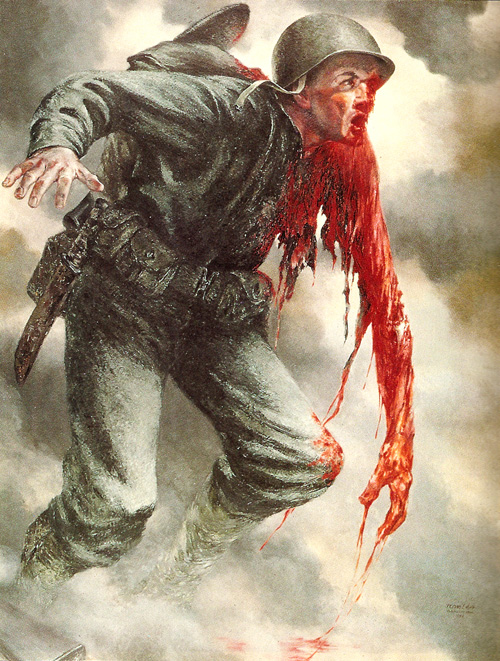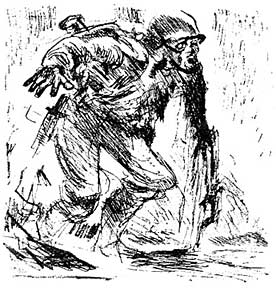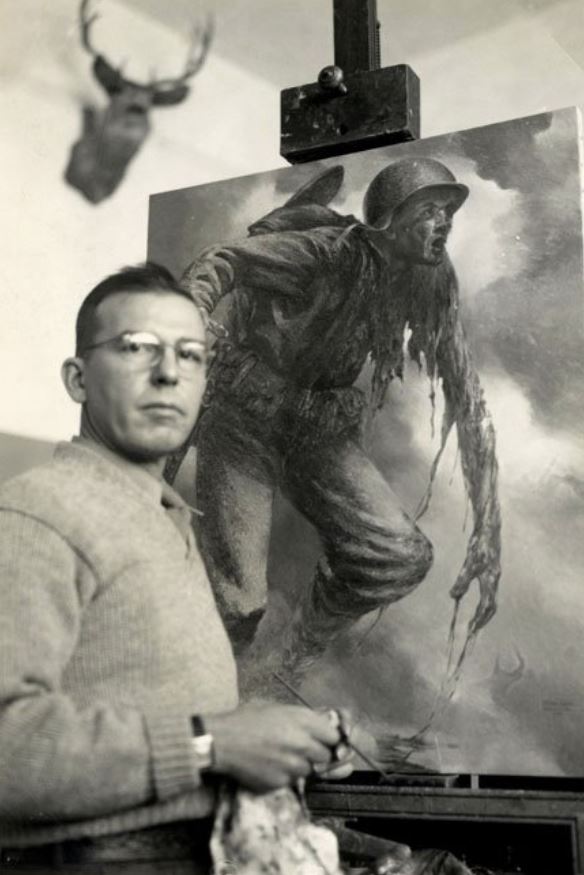Tom Lea & the Art of War
While on a visit to my local library as a nine-year-old in 1962, I randomly pulled a dog-eared picture book about the Second World War from a shelf, retreating to an isolated table to thumb through the digest in solitude. Flipping through the book’s tattered pages I received an unexpected surprise I would never forget. I had come to a full-page color reproduction of a painting portraying a horrifically wounded U.S. Marine, and I literally froze in disbelief, staring incredulously at the appalling image. The artwork depicted a gravely wounded soldier, still standing, but with half of his face blown away and his entire left arm reduced to a bloody pulp. All of my juvenile notions regarding war evaporated while gazing at that single image. I left the library shaken to my core.
It is difficult to describe how that painting unsettled me. The assassination of John F. Kennedy was still a year away and the horror of Vietnam had yet to creep into the American psyche. I had seen the shocking imagery of Francisco de Goya’s Disasters of War series, as my parents had a well stocked home library of art books, but Goya’s images were from a distant and shadowy past that I could not fathom. My experience in the library was something else altogether, the dreadful image of that bloody soldier was rendered in full color and it depicted fairly recent history. Despite the passage of time my memory of that painting never faded, though the work became lost to me in another way. As an adolescent it never dawned on me to write down the name of the artist and the painting, or the title of the book I had found the image in, so decades later those facts remained a mystery to me, that is – until just recently.
Last June I visited the Brand Library in Glendale, California, which has an enormous collection of books exclusively dedicated to the subjects of art and music. Meandering through the aisles my eyes suddenly caught the title of a large format book, The Art of War. I plucked it from its shelf and took it to a quite table where I could examine its contents at my leisure. I randomly opened the book towards its middle section and was astonished to see the very painting I had discovered forty-seven years ago as a boy; I had found it in a recently published book, but it was the same painting.

The artwork in question was painted by Tom Lea and titled, The Price. The artist created it while employed by LIFE magazine as a war artist in the Pacific Theater of war. Lea was attached to a Marine unit that assaulted the Japanese held island of Peleliu, and he was trained and equipped like every other Marine, except that he went into battle armed with a sketch pad and pens as his primary weapons. Lea had actually witnessed the soldier’s death during the bloody landing, and he sketched the soldier’s agony as it occurred. Back in the studio Lea transformed his black and white pen sketch into an unforgettable oil painting, which is now a permanent part of the U.S. Army Art Collection. In the battle for Peleiu, the U.S. Marines suffered 1,121 killed in action, with over 6,000 casualties. All 10,000 Japanese soldiers holding the island were killed. Reporting for LIFE magazine on the story of the invasion, Lea would write of the brutal landing:
“I fell flat on my face just as I heard the whishhh of a mortar I knew was too close. A red flash stabbed at my eyeballs. About fifteen yards away, on the upper edge of the beach, it smashed down four men from our boat. One figure seemed to fly to pieces. With terrible clarity I saw the head and one leg sail into the air.
I got up… ran a few steps, and fell into a small hole as another mortar burst threw dirt on me. Lying there in terror looking longingly up the slope for better cover, I saw a wounded man near me, staggering in the direction of the LVTs (Landing Vehicle – Tracked). His face was half bloody pulp and the mangled shreds of what was left of an arm hung down like a stick, as he bent over in his stumbling, shock-crazy walk. The half of his face that was still human had the most terrifying look of abject patience I have ever seen. He fell behind me, in a red puddle on the white sand.
It was established later that the invasion of Peleliu as a stepping stone to the invasion of the Philippines had not been necessary – Gen. MacArthur had already bypassed the Palaus and landed at Leyte in the Philippines.”
In retrospect I have come to understand how Lea’s painting of that mortally wounded soldier influenced my own work as an artist. Lea’s painting was a successful attempt at encapsulating the unvarnished truth. Obviously The Price was not a pretty picture, but its journalistic approach effectively captured an unpleasant reality that was necessary for people to confront. That same journalistic methodology became integral to my aesthetic viewpoint.
Lea’s painting could be interpreted as war propaganda, but it is an odd style of state propaganda that depicts the terror, futility, and brutality of war. Lea was not alone in painting or sketching images that were bone-chillingly frank and uncompromising in the portrayal of war. The U.S. military employed over 100 soldier and civilian artists to record the events of World War II, and much of their output was extraordinary.

They Drew Fire, the PBS gallery of artworks created by combat artists of World War II, gives ample evidence of this blunt forthrightness. It is instructive to review the entire portfolio. Tom Craig’s Bone Pile at Cassino, George Biddle’s Dead Civilians, Howard Brodie’s Execution, Richard Gibney’s The Last Full Measure, and Kerr Eby’s Helping Wounded Man, are just some of the artworks created by U.S. military artists that revealed the true face of war. That this type of imagery was at the time published in LIFE Magazine and other publications with official sanction begs the question – why do we not see equivalent artworks from today’s wars in Afghanistan, Pakistan, and Iraq?
The U.S. Armed Forces still employ soldier-artists, and today a number of them have been assigned the task of interpreting war experiences in Iraq and Afghanistan. The U.S. Army Center of Military History maintains a website titled, Army Artists Look At The War On Terrorism, and the dissimilarity between the art produced by soldier-artists of the 1940’s and those now deployed in Iraq and Afghanistan could hardly be more pronounced. The first apparent difference is artistic quality. The soldier-artists from the 40s were distinctive draftsmen well versed in composition, color theory, perspective, and the like; present day combat artists suffer from a lack of such proficiency while displaying a slavish over-reliance upon photography.

More importantly, today’s soldier-artists seem unable or unwilling to create works filled with the pathos, tragedy, and simple candor routinely delivered by their compatriots in the 40s. Artists working for the U.S. Armed Forces during the Second World War depicted civilians and soldiers suffering from wounds, madness, and death, as well as portraying shattered cities and devastated landscapes. While there were also a great number of images showing glory and heroism, these were generally accomplished with no small degree of honesty.
“War is Hell,” so it is said, and no one knows this better than a soldier. But in Army Artists Look At The War On Terrorism, there are no paintings of horrifically wounded U.S. soldiers nor are there bloody field hospitals, there are no watercolors of U.S. troops with that shell-shocked look about them, no drawings of dead civilians or towns reduced to rubble – no suicide truck bombers, improvised explosive devices (IED), or U.S. drone missile attacks. The “big picture” has been reduced to a narrow peep hole, where only gallant and brave U.S. soldiers can be viewed.
At present some 10,000 U.S. Marines are fighting the Taliban in Afghanistan’s Helmand province in an operation dubbed “Strike of the Sword.” At the time of this writing, 26 U.S. soldiers have died in the campaign – so far. British soldiers are also fighting in Helmand, with 15 of them having been killed since the beginning of this month, eight in one day of fighting last Friday. It is not known just how many Afghanis have been killed but casualties are likely to be in the hundreds. Suffice it to say, President Obama’s Afghan war, or “Overseas Contingency Operation” as he puts it, will not likely employ an artist like Tom Lea to create anything approaching the profundity of The Price.
— // —
For more works by Mr. Lea, visit the Tom Lea Institute website
Incidentally, the book in which I recently rediscovered Tom Lea’s The Price, is titled Art of War: Eyewitness U.S. Combat Art from the Revolution through the Twentieth Century, by Col. H. Avery Chenoweth, USMCR (Ret.)

